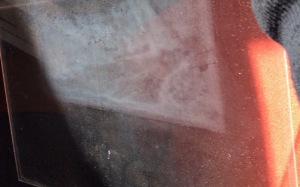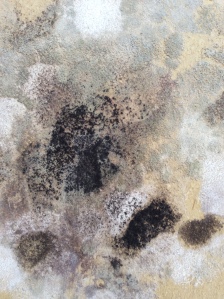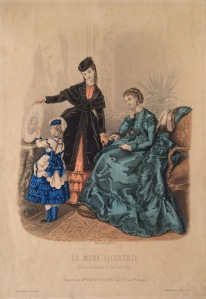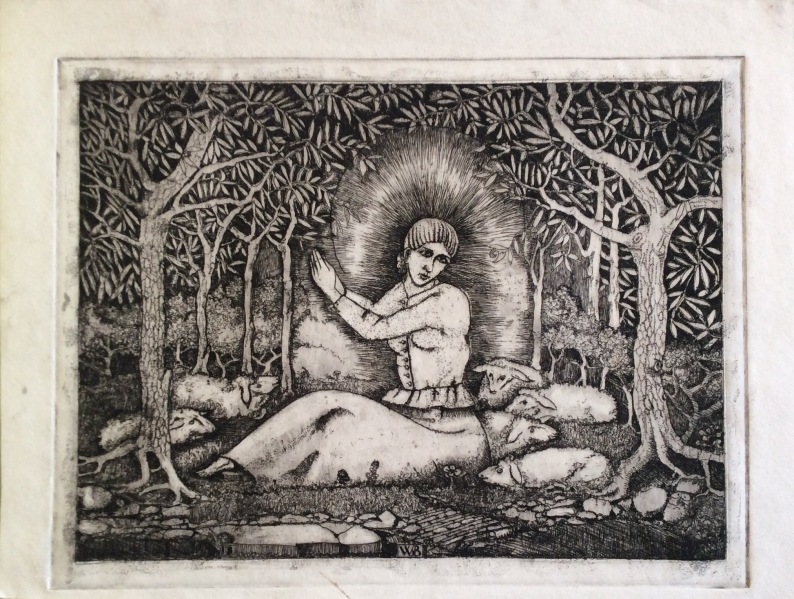Cleaning the “hardware” of artworks vintage or antique.
Micro-organisms can feast on paper artworks, books, posters and comics in the right circumstances. Used framing materials like the backingboard and even glass can be affected by these micro-organisms. Next to fungi, sometimes bugremains, bugpoop and dust is present behind the framing. All the framing materials must be cleaned thoroughly and sometimes even sterilized before they can be re-used. Sometimes the damage is so severe, its best to start fresh and use a new frame and piece of glass to prevent fungal contamination. However most of the time it adds to the artwork if you can keep the original materials and re-use them.
Cleaning and sanitizing the glass
 If you can, take this nasty chore outside because you shouldn’t breath in the spores. Its best to wear a mask and rubber gloves. Glass that has been covering a moldy artwork, is best cleaned with rubbing alcohol, (70%) and hydrogen peroxide (3%). First, remove all the dirt on the glass by spraying it with water. Wipe it with a paper towel so all the superficial dirt is gone. Spray the glass plate with the hydrogen peroxide in a spray bottle. Leave it for an hour or so. The spores are dead. To de-grease and clean the plate use rubbing alcohol on a soft cloth. Wipe and dry the glass but not completely to prevent a electrical static reaction that attracts particals and dust to the glass plate. To prevent this you can let the glass dry by air for the last part. From then on wear gloves when handling the glass (for example when you are ready to frame). This is to make sure you don’t transfer anything to the plate and prevent fingerprints to show up on the glass. You should now have a nice fresh and sanitized glass plate ready to use.
If you can, take this nasty chore outside because you shouldn’t breath in the spores. Its best to wear a mask and rubber gloves. Glass that has been covering a moldy artwork, is best cleaned with rubbing alcohol, (70%) and hydrogen peroxide (3%). First, remove all the dirt on the glass by spraying it with water. Wipe it with a paper towel so all the superficial dirt is gone. Spray the glass plate with the hydrogen peroxide in a spray bottle. Leave it for an hour or so. The spores are dead. To de-grease and clean the plate use rubbing alcohol on a soft cloth. Wipe and dry the glass but not completely to prevent a electrical static reaction that attracts particals and dust to the glass plate. To prevent this you can let the glass dry by air for the last part. From then on wear gloves when handling the glass (for example when you are ready to frame). This is to make sure you don’t transfer anything to the plate and prevent fingerprints to show up on the glass. You should now have a nice fresh and sanitized glass plate ready to use.
Backboard and cardboard
Next we have the backingboard material. This is often made of thick plates containing fibrous woodpul p and a glue that keeps it together. Fungi love this stuff, especially combined with moist and a high enough humidity. The fungi on the left started decomposing the backboard after it was treated on a good splash of water and high temperatures. The several species of fungi went for the cardboard and not the mulberry paper. When backing panels and backboards show any signs of mold its best to through them away right away to prevent contamination via the spores.
p and a glue that keeps it together. Fungi love this stuff, especially combined with moist and a high enough humidity. The fungi on the left started decomposing the backboard after it was treated on a good splash of water and high temperatures. The several species of fungi went for the cardboard and not the mulberry paper. When backing panels and backboards show any signs of mold its best to through them away right away to prevent contamination via the spores.
Since fungi are truly a biohazerd, handle with care and don’t move it about to much, place in a plastic bag and discard. Spores can be dangerous for people with astma and other lung diseases. The backboards are best to replace with acid free materials like museum board or archiving board, and sealed with a good quality tape. I use Tesa double sided ECO tape for that. Its a very broad tape so you can close the gap between the frame and the board and coat it with waxed brown paper.
Cleaning of the frame
The frame is often very dirty. When molds where present in the artwork, its best to clean the frame very thoroughly also on the inside. The frame usually has a layer of laquer on it, its not always a good idea to wipe it with a aggressive cleaning agent because this will remove or damage the laquer on the frame. You can clean the front depending on the material that was used for the frame. The inside of the frame (the ridge where the glass falls in) can be cleaned with a soft cloth and some hydrogen peroxide on the cloth. Be aware that hydrogen peroxide also works as a bleaching agent. When you are not sure, test a little spot before starting this procedure. Some other anti bacterial and fungi killing agents are:
vinegar (kills about 78%), baking-soda, chloride bleach, ammonia, (UV- radiation en cold temperatures)
Detecting mold in old artworks
- There are a few signs that can tell you if there is mold present in a artwork. First is the powdery dust of mildew. When the white powder is dry and powdery, the fungus is probably not active. When its creamy and wet-like, it is active.
- The second hint is the signs of water d
 amage on the the artwork, like tide lines and water spots on the cardboard.
amage on the the artwork, like tide lines and water spots on the cardboard.
- The last clue is the presence of strange stains like you can see here on the left. When opening up this artwork there was indeed a patch of mold at the backside of the stained area caused by water damage. This also shows that its important to dry art that has been subjected to water damage.
Preventing Mold on artworks
Preventing mold is always the best option, some simple rules can help the climate in the artwork so it becomes a less attractive snack for those decomposing organisms.
Keep a steady climate environment The best climate is 70 degrees Fahrenheit and 50% humidity. Try to prevent sudden variations as much as you can.
Use acid-free materials for framing. To maintain the quality of the artwork acid will deteriorate the paper.
Remove the paper from its frame when its has been wet. Let it dry completely between blotter papers.
Keep the artwork clean. Dust and soil will attract bugs and microorganisms. (clean the glass with a damp cloth, not spraying any moisture directly on the glass.
Don’t hang the artwork in the sun
Make sure the artwork can breathe, place some distance between the artwork and the wall. Make sure the artwork is not placed against the glass but lies on a mat or is placed on spacers.
When the artwork is wet, always remove it from the frame and let dry between felt or blotter paper.
 “Youth IV” by Bernadina Midderigh Bokhorst. This print belongs to a series of decorative plates made for children to decorate walls in schools or children rooms and look just like a pencil drawing. This lithograph is very sweet and innocent and highly collectible!
“Youth IV” by Bernadina Midderigh Bokhorst. This print belongs to a series of decorative plates made for children to decorate walls in schools or children rooms and look just like a pencil drawing. This lithograph is very sweet and innocent and highly collectible! 


















































